Your feedback is important to us
Please provide any feedback you have. Thank you!
Thank you!
Your feedback has been submitted.
 California Assessment of Student Performance and Progress
California Assessment of Student Performance and Progress
Please provide any feedback you have. Thank you!
Your feedback has been submitted.

See what skills are tested, understand your child's scores, and get ideas for how you can help at home.
Fifth graders should be diving into so-called “complex” text with confidence. For example, because of longer sentences and a story that deals with loss, A Wrinkle in Time is considered complex fifth grade fiction.
To make sense of new words, kids should look for clues in what they’re reading. For example, they might look for a definition within the text or try substituting an easier word that they suspect means the same thing.
To help them understand the main idea, fifth graders should look closely at how the material they’re reading is organized. They should look at details, too, and think about how those details support the main idea. For example, in a text about Helen Keller dedicating her adult life to helping others, there should be details that help make the main point, like her founding the ACLU and sticking up for people with disabilities.
Watch how a teacher gets fifth graders to show what they’re learning as they read.

Fifth graders are expected to think deeply about what they read. In fiction, they should analyze a character’s traits and think about how those contribute to his actions. In nonfiction, they might analyze why certain information is organized under separate headings and chapters.
Students are expected to read several books or articles on the same subject and take notes, gathering the most important information. Fifth graders should be able to quote directly from what they’ve read to support their ideas during class discussions and in their writing.
Kids continue to work with figurative language, such as metaphors (a comparison of two unlike things: life is a highway) and similes (a comparison using like or as: brave as a lion).
Figurative language can be especially challenging for English learners. First they need to learn the literal meaning of the words, then they can try interpreting symbolism in phrases. (Imagine trying to understand the elephant in the room if you were learning English!)
A fifth grader struggling to understand the main idea of a text needs a lot of reading practice with modern classics like Holes or Because of Winn-Dixie and articles from online sources like Newsela. Fifth graders should be reading at least 30 minutes a day. Children who are behind need to spend extra time reading at and above their level in preparation for sixth grade, which can be a difficult year. Here are some high-level and interesting books for your fifth grader.
Want to know one of the most powerful ways to inspire your child to read? Read for your own pleasure! Seeing you read the morning newspaper, a book before bed, or a favorite blog goes a long way toward showing your child how reading can enrich a person’s life. Establish a regular 30-minute (or more) family reading time (daily is best, but weekly can work). Everyone in the family has a book, magazine, or tablet to read. When the time ends, ask everyone to share what they learned.
The best way to help your child understand what he reads is to talk about it. Ask your child:
Your child should learn about 2,000 new words in fifth grade — and most of these new words should come from what he reads. When your fifth grader finds a new word, he should try to figure out what it means. Here’s how:
These lessons at BeaLearningHero.org will give your fifth grader some practical experience reading a variety of subjects, finding evidence, determining the main ideas, and using clues in the text to improve her skills. And check out these books that come with discussion guides so you can work with your child on those reading necessary skills.
Watch how a teacher guides a fifth grader through the process of figuring out new words.

It’s important for fifth graders to build their academic vocabulary. These are words that are used often, in many subjects, but can be hard to define, such as approximate, frequent, and escalate. Academic vocabulary is also more precise, like saying announced, claimed, or concluded instead of said. Check out this list for more academic vocabulary words to use with your fifth grader.
To increase your fifth grader’s academic vocabulary, introduce a new word every day. Tell your child to look up the new word and have him find another word that means the same thing. Next, ask your child to make up a sentence using the word. For fun, help your child start a daily word journal where he creates a sentence using each day’s new word. Maybe he’d like to draw a picture to illustrate his sentence. The more memorable the sentence, the better!
To understand figurative language, like metaphors and similes, kids need lots of practice. As you read books and watch TV together, point out examples of figurative language, like shake it off. As your child learns a new phrase, like strong as an ox, ask her to use it in a sentence. See if you can find 10 or 15 examples in one week.
Here are four teacher-recommended books that use lots of figurative language:
The Giving Tree by Shel Silverstein
The Phantom Tollbooth by Norton Juster
Fair Weather by Richard Peck
Snicker of Magic by Natalie Lloyd
Fifth graders need to be pretty good at identifying the main point, drawing conclusions, and finding evidence in what they read. Ask your child’s teacher about each of these skills. Is your child quick to identify the main point? Does she tend to draw the right conclusions? When your child points to evidence, is it the strongest example, or more of an extra detail? Knowing your child’s strengths and weaknesses will help you figure out the best ways to help him build these skills.
Writing and reading go hand in hand. Fifth graders need to use information they read in books and articles as evidence in their writing to support their main idea. When writing, your child should both quote and paraphrase information they’ve read.
Your fifth grader’s writing should be organized. Kids need to clearly introduce their topic and present related information in the form of a few clear, well thought-out paragraphs. They should draw on facts, definitions, concrete details, quotes, and examples from their research to thoroughly develop their topic. At this age, students should use advanced linking words (e.g., in contrast, especially) to form compound and complex sentences that convey their points. To wrap it up, your child should have a well-reasoned conclusion.
See what the writing process looks like for a fifth grader.

As their vocabulary grows, fifth graders need to use new words they’ve learned to give more accurate descriptions. For example, instead of David said, they might write David bellowed to better portray David’s mood.
Whether telling a story (narrative writing), writing a report (informational writing), or convincing the reader of their point of view (opinion writing), fifth graders should be able to revise their own work to catch errors and improve how their writing flows.
See what teachers are looking for in your fifth grader’s writing.

Fifth graders are full of ideas! It can be hard for them to keep focused on just one, but that is what they need to do. It’s important for students to read their work aloud to hear how it sounds. It’s a good way for them to double-check that they are explaining ideas clearly and that their sentences are complete. This is usually when kids notice errors or missing information. Their expanding vocabulary should help them choose the best words to describe their ideas.
Read a few real-life examples of fifth grade nonfiction writing.
Writing should be fun! Find out what your child enjoys reading (comics, funny poems, letters, stories, etc.) and ask her to try writing in that format. Remember to celebrate your child’s ideas.
Use these tools at BeaLearningHero.org to understand what’s expected of a fifth grader when the test and teacher talk about informative/explanatory, argumentative, or narrative writing. Also have her try the WriteAlong to practice.
Fifth graders may struggle to stay focused on their writing topic. Ask your child’s teacher for organizing strategies you can use at home to help keep your child’s related ideas grouped together.
Fifth graders know how to talk! But they also need to know how to listen. They should be speaking in complete sentences and listening attentively to their peers during classroom discussions. They should share their own insights, add to the ideas their classmates share, and come to their own conclusions based on what they’ve read and heard during discussions.
At this age, students should be able to give summaries of ideas they hear in audio or video. They should also be able to cite evidence to support their ideas while talking. For example, after watching a narrated video about the body language of elephants, fifth graders should be able to conclude that elephants have their own ways of communicating and note that the elephant’s head waggle means it wants to play.
After hearing a presentation or class discussion, fifth graders should be able to identify the key ideas and most relevant information. When they’re speaking, even in group discussions, students should use words and phrases that best express their ideas, which often means using new vocabulary.
Fifth graders work on their speaking and listening skills in whole-class and small-group discussions. The state test, however, only covers listening skills (at least for now).
For the test, fifth graders listen to a recording and answer questions about the main idea to demonstrate their ability to listen attentively and capture the most important ideas.
Fifth graders need to be able to restate the main idea and details of what they hear. Ask your child’s teacher what questions to ask to prompt your child to summarize or paraphrase what he hears.
Fifth graders should be doing research using print and online sources. They need to use the information they find to support their ideas in discussions and when they’re writing.
Kids should be able to summarize what they read and consider which facts or details — including information from charts, timelines, and graphs — best support their ideas.
Taking notes becomes a pretty big deal in fifth grade. It’s not just writing things down; it’s remembering what information came from which source. It’s also reviewing and categorizing the new information so they can present it in a clear, organized way. For example, What did they find out about the animal’s habitat from each source?
Watch how fifth graders do research for an essay.

Fifth graders learn that information comes in many formats, including books, articles, graphs, tables, and timelines. As students read a variety of sources, they should take notes, begin to identify facts that support their ideas, and use the facts as evidence when they write. To understand new words, students should become familiar with using a dictionary, and use a range of strategies such as context, root words, suffixes, and prefixes. For example, aqua means water and arium means place, so they can figure out that an aquarium is a place where fish are kept.
This list of books chosen with fifth graders in mind also comes with a guide to discussing each book! You’ll know exactly how to get your child chatting.
Fifth graders may struggle to recognize which information would be best to use in their writing. Ask your child’s teacher what questions to ask to help your child connect facts to his writing topic.
In fifth grade, students learn to add and subtract fractions with different denominators (the bottom numbers) and mixed numbers (a whole number with a fraction, such as 4 2⁄5) by finding common denominators. For example: 2⁄3 + 3⁄4 is the same as 8⁄12 + 9⁄12, which equals 17⁄12 or 1 5⁄12.
Watch how a fifth grader finds the common denominators in fractions.

Students move into multiplying fractions and dividing whole numbers by unit fractions (1⁄2, 1⁄3, 1⁄4, 1⁄6, etc.) and the reverse: dividing unit fractions by whole numbers. For example, dividing 8 by 1⁄2 is really asking how many times 1⁄2 can fit into 8. The answer is 16. Dividing 1⁄2 by 8 asks how to break down 1⁄2 into 8 smaller fractions. The answer is 1⁄16.
Students quickly realize two rules they can use for quick mental math:
Watch how these fifth graders explain how to multiply fractions.

Fifth graders also need to understand that decimals are another way of showing fractions — for example: .25 is equivalent to 25⁄100 or 1⁄4. At this age, kids learn to think about place value of numbers with decimals to the thousandths place with a new understanding of base 10. This means really understanding that a number in the tens place represents ten times as many as it would in the ones place. It also means that a number in the hundredths place represents 1⁄100 of the value it would in the ones place. For example, 345.67 can also be expressed as (3 x 100) + (4 x 10) + (5 x 1) + (6 x 1⁄10 ) + (7 x 1⁄100).
By the end of fifth grade, students need to fluently add and subtract numbers with decimals to the hundredths place. (For example, 345.67 + 7.89 and 456.78 – 234.56.) They also need to be able to multiply and divide numbers with decimals to hundredths place with multi-digit whole numbers. (For example: 540.25 x 318 and 678.99 ÷ 213).
This is also the year that students delve deeper into geometry by learning how to measure the volume of a right rectangular prism (a 3D shape with six rectangular sides). For example, think about figuring out how many 1-foot-square boxes can fit in a truck. Imagine that the truck is a cube, and the boxes fill it to the top without any open space inside. Kids learn to multiply the shape’s width x its height x its length to find the volume.
Children get their earliest foundation of place value in kindergarten when they begin working with numbers from 11 to 19. By the end of fifth grade, students need to understand place value for decimals to the thousandths place. Students are taught to make sense of this by breaking down the number this way:
853.5 = (8 x 100) + (5 x 10) + (3 x 1) + (5 x .1) = 800 + 50 + 3 + .5 = 853.5.
Sample problem 1: Place value
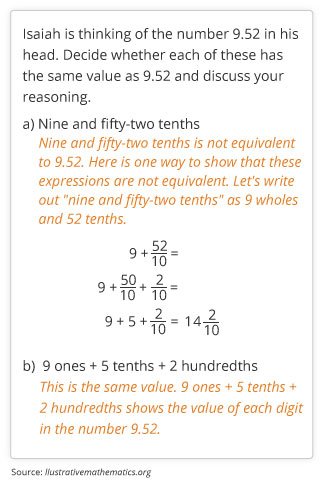
>
Students need to understand place value in order to compare decimals. This number line question shows what students may be asked to do on a test.
Sample problem 2: Comparing decimals
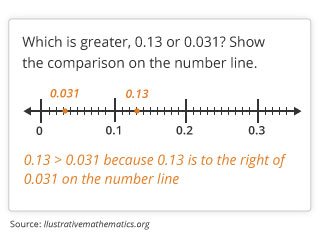
Fifth graders make a big jump in fractions. In fourth grade, they learned about equivalent fractions (such as 1⁄2 = 2⁄4 = 3⁄6 = 4⁄8, etc.). Fifth graders need this knowledge of equivalent fractions to add and subtract fractions. Here’s a sample problem that requires students to show this understanding.
Sample problem 3: Finding a common denominator and adding fractions
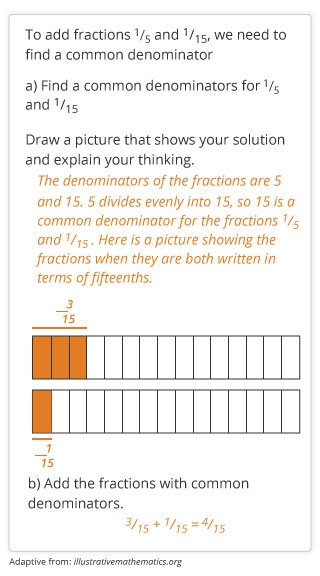
Fifth graders learn to multiply a fraction, like 1⁄3, times a mixed number, like 2 1⁄13.
Sample problem 4: Multiplying fractions and mixed numbers
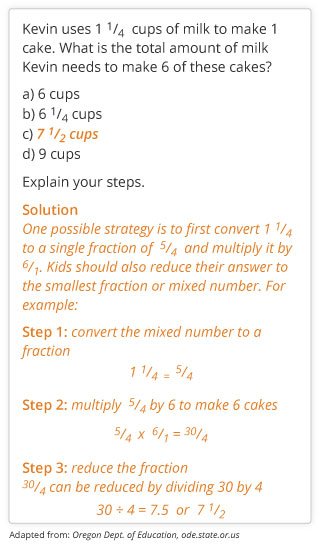
Fifth graders are expected to become proficient at dividing whole numbers by fractions and vice versa.
Sample problem 5: Dividing whole numbers by unit fractions (and vice versa)
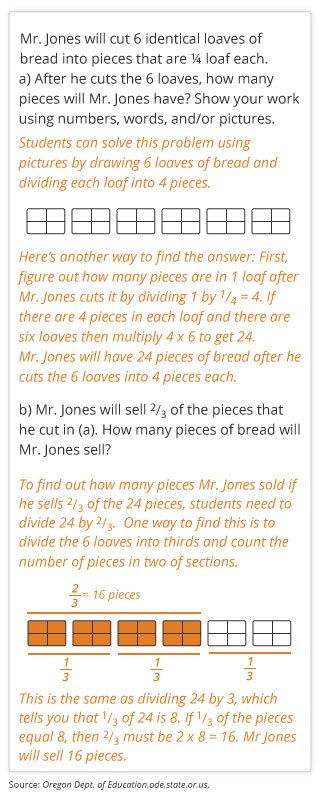
In fifth grade, students learn that volume is the space inside a three-dimensional object, and they learn to calculate the volume of right rectangular prisms by multiplying length x width x height. For this problem, students have to imagine that they’re filling each rectangular prism to the top with 1-centimeter (cm) cubes.
Sample problem 6: Finding the volume of right rectangular prisms
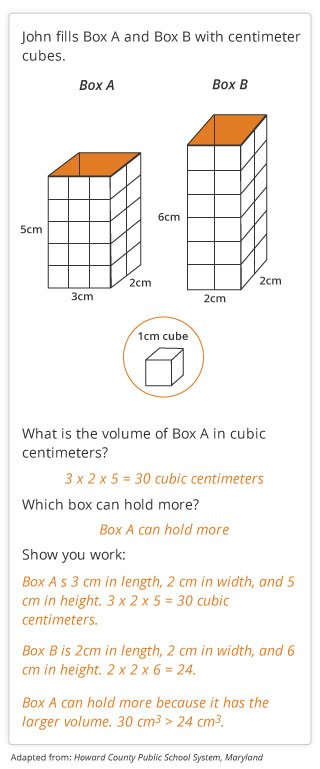
In a world without math, you couldn’t count your money, your children, or your blessings — not necessarily in that order. Need another reason to share the joy of math? Research shows that when parents communicate their math anxiety, their children struggle in math class. So turn that minus sign into a plus — at least when you’re with your kids.
Is your child on track to succeed in fifth grade math? Ask the teacher! If not, what are his strengths and weaknesses? Find out how you can help your child work on weak areas at home.
By fifth grade, students should be able to read a word problem and start figuring out the solution in their heads. That’s known as thinking skills (or mathematical reasoning), which students develop as they learn to pick up clues in the language and rules of math. Students are expected to use the different strategies they’ve learned to analyze the problem, determine the steps to take, and find the solution. This takes trial and error and a lot of perseverance.
Using modeling and data analysis skills, fifth graders should create diagrams, graphs, charts, and tables to identify the important numbers or quantities and show how they’re connected.
If the problem asks how much remains, for example, fifth graders know they’ll be using subtraction. If they’re asked how many times greater one number is than another, students should know they’ll be multiplying.
Fifth graders are also expected to estimate answers based on rules they’ve learned about fractions and place value. For example, the product of a whole number multiplied by a fraction that’s less than 1 will always be a number that’s less than the whole number.
See how fifth graders estimate answers to word problems.

Think about how you use math in your life. Probably not a day goes by that you don’t compute, calculate, or count. Which gas station is cheaper if one charges less per gallon than another but charges you a fee to use your bank card? If there are seven of us for dinner and we’ll each eat ⅓ pound of chicken, how many pounds do I need to buy? Knowing how to think through complex problems is an important life skill. By the end of fifth grade, students should be able to analyze situations that arise in their lives and figure out the best strategy for finding the solution.
Sample problem 1: Making sense of a word problem, picking the right operations, and persevering to solve it
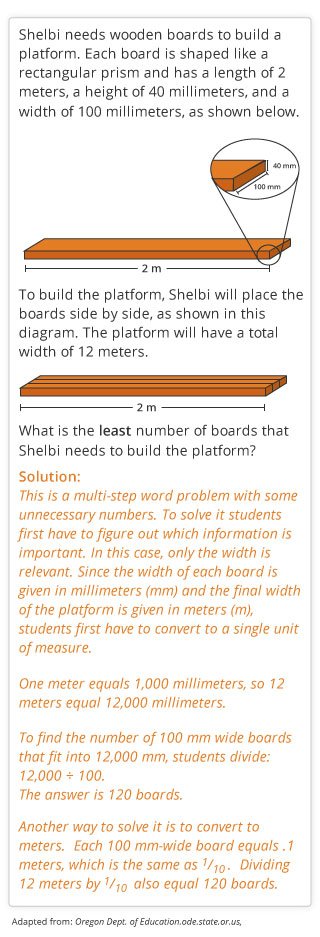
Numbers are second nature. As babies, we learn to connect numbers to something tangible — a picture of three bears, three stuffed animals in the crib. Visual models are an important tool for understanding math. Students are expected to progress from counting toys to creating charts, graphs, tables, diagrams, and number lines.
Sample problem 2: Analyzing complex, real-world situations and using models to solve them
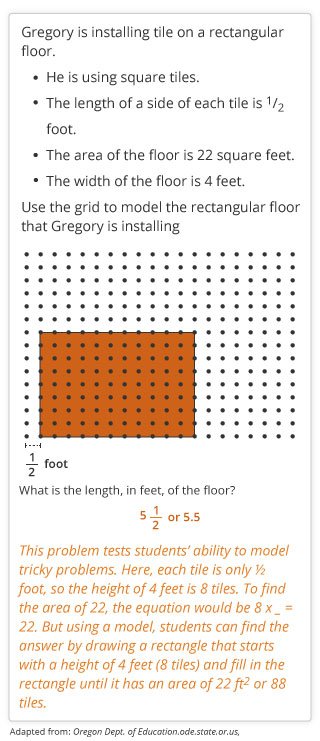
You know the saying: children learn by example. Even if you’re one of the people who suffer from math anxiety, it’s best for your child to keep that dread under wraps. Instead, try to embrace math and show your child how useful it is in everyday life.
We tell our children to ask their teacher for help; we can (and should) do it, too. Set up a meeting with your child’s teacher and ask for ideas to help your child develop her problem solving abilities.
In fifth grade, students are expected to look at how other students solve problems and then evaluate their classmates’ strategies and critique their reasoning.
Fifth graders are expected to do more than find the answer — they’re expected to defend their work by creating a logical and convincing argument using charts, graphs, and other models. They also have to flip that process around to critique their classmates’ work and explain why they think it’s correct or incorrect. This process requires students to apply all the math skills they’ve learned to analyze a problem, identify the steps necessary to solve it, and be able to explain the mathematical reasoning behind their approach.
Watch how fifth graders explain whether they agree or disagree with a classmate’s solutions and why.
Oh yeah? Prove it! Kids say that to each other all the time. One way fifth graders have to prove things (at least in math) is by creating charts, tables, graphs, and other visuals that contain the important data, are organized to show how the numbers or quantities relate to each other, and illustrate how they worked out a problem.
Sample problem 1: Constructing clear and logical arguments to support their work
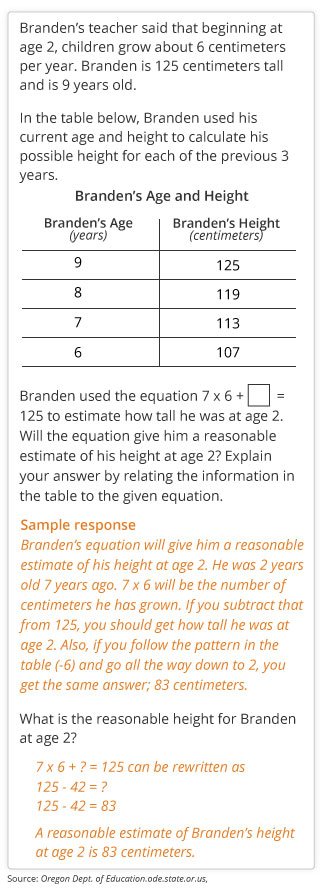
Students are also expected to learn from each other under the new standards. By critiquing each other’s work in a safe and respectful manner, fifth graders may find that they’ve made similar mistakes. This process also helps them learn how to construct clear and logical arguments to support correct answers and explain the problems that lead to incorrect answers.
Sample problem 2: Critiquing a classmate’s problem solving
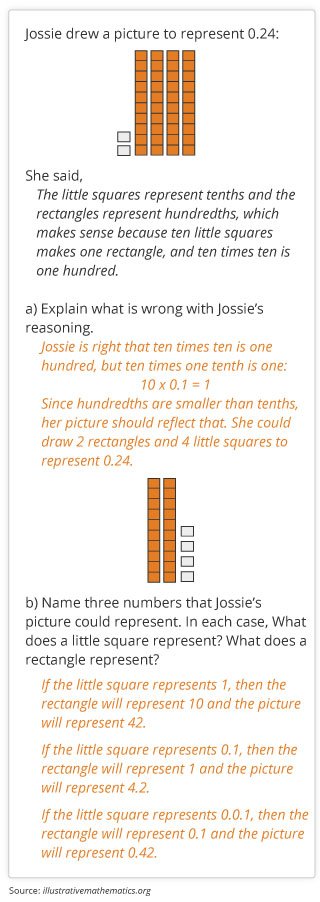
Attitude is a little thing that makes a big difference. That quote by Winston Churchill is great advice for all things in life, especially learning math! This is doubly true when it comes to “communicating reasoning,” since it involves kids using their powers of persuasion to explain and stand up for their thinking.
Learning is complicated. Your child may be great at memorizing things, like which step goes first, but struggle to communicate why she’s following those steps. See if the teacher has ideas about how you can help your child practice communicating her thoughts so she’ll be able to share her reasoning in math class.
GreatKids created this guide to help you understand your child's state test scores and to support your child's learning all year long. We worked with SBAC and leading teachers in every grade to break down what your child needs to know and exactly how you can help